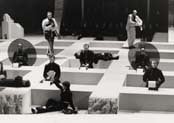OPERA SEARCH

Patmos
(1989)Libretto adapted from the Book of Revelation by D E Sattler (G)
Major roles: S,A,T,Bar,B; minor roles: 3S,3A,CT,T,Bar,B;
boys' chorus; dancers
1.afl.1.corA.Ebcl.bhn.1.dbn-2.2.atrbn.ttrbn.0-timp.perc(2):glsp/xyl/
tubular bells/tgl/sleigh bells/cowbells/large cowbell/susp.cym/cyms/
tam-t/2 pairs of bongos (large and small)/tamb/SD/TD/BD/2wdbl/
2tpl.bl/2maracas (different sizes)/guiro-harp-strings(5.0.4.3.1)
Abbreviations (PDF)
Boosey & Hawkes
Munich Biennale
Ruth Berghaus, director
Conductor: Adam Fischer
Company: Staatstheater Kassel
| JOHANNES I | Tenor |
| JOHANNES II | Baritone |
| X | Bass |
| ANGELUS NOVUS | Soprano |
| ANGELUS ANTIQUUS | Contralto |
| TERZETT I | 3 Sopranos |
| TERZETT II | 3 Altos |
| QUATUOR (THE FOUR BEASTS) | Countertenor/Tenor/Baritone/Bass |
| CHILDREN'S CHOIR (the 24 eldest) | 12 Sopranos, 12 Altos |
| 2 CHILDREN'S VOICES FROM THE CHOIR | Soprano/Alto |
| SPEAKING CHOIR | Players in the orchestra |
| Angel with incense/The Wife/Fiance of the Lamb/Babylonian Whore | Female Dancer |
| The Lamb/Michael/Angel with scythe | Male Dancer |
| The Dragon/Angel with the heavenly host | Male Dancer |
| First Beast | Male Dancer |
| Second Beast | Male Dancer |
| The Four Horsemen of the Apocalypse | 1-4 Male Dancers |
| The four Angels of the Wind | 1-4 Male Dancers |
| The seven Angels of the Plague | 1-4 Male Dancers |
According to the old Jewish calendar, the sixth millennium of our history is just beginning its last quarter, its ‘evening hour’. The advanced state of civilisation on our planet enables us to foresee the plagues and ruin to come – it even compels us to think of the end. Here we stand, looking back hopelessly across the generations and the millennia at the chances lost, the teachings neglected, and the prophetic spirit shunned or betrayed. That spirit informs a wonderful New Testament text that is about us and is our concern. The Apocalypse – the Revelation of St John the Divine – is at once a cultural critique and a penitential sermon. Both derive from the great tradition of the old Jewish prophecies, and spring directly from the early Christian era. Uniting them is a synoptic vision of finite history, with its metaphysical horizons vaulted above.
Wolfgang von Schweinitz
Poetic
